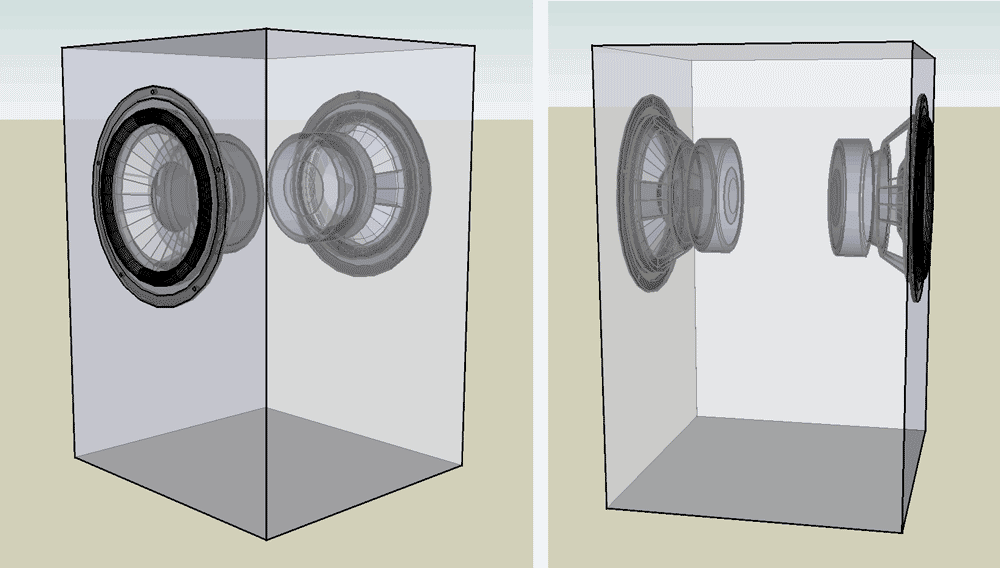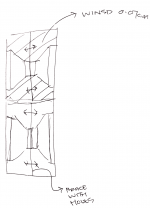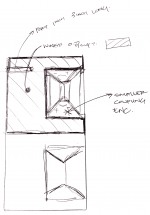hi planet10 - here's an overview of a boominator https://www.instructables.com/id/The-Boominator-360-of-115dB-music/
Hmmmm interesting.....if I Google push push driver configuration it brings up isobaric. Basically I've heard a few people raving about this boominator and it has quite a following, which made me think "I wonder if I could do this with a 3.5inch BMR full range and keep the box size down
Those look like a pair of drivers loaded push-push (poorly done IMO). Not at all isobarik.
dave
hey Dave, do you think something like this could be done right with a set of 3.5inch full range drivers or is this something only really suited for mids and subs.
Also how does one size the enclosure correctly? I found myself with some spare time this morning and started googling and found a sketch of yours from 2009 where there was a bit of a gap between the magnets with 2 vertical boards and a central horizontal brace.
I'm trying to figure out how to get something small that performs like a bigger enclosure would. recently failed with using ND65's and have successfully used the Tectonics TEBM65's tuned to 55-60Hz on a few projects , hence looking at this push-push method if it halves the box size. My end goal is to sit down next to some mates with their Bose mini things and blow them away lol.
What configuration is the boominator? I thought it was ISO, but lead to believe it is not. If we make the assumption that it is actually push-push, the two drivers still share the enclosure, with a central brace, similar to that of the iso....so how does one size what the configuration of the boom is?
hey Dave, do you think something like this could be done right with a set of 3.5inch full range drivers
Search for bipoles. Many have been done. Experiance has us leaning towards placin gthe 2nd driver on the ip instead of the back. The miniTower “clone” is an example.
Also how does one size the enclosure correctly?
2 woofers need 2 x the volume (and 2 x the vents (or eqivalent) if the box is vented.
dave
The boominator has 4 woofers, 2 per channel push-push, that the enclosures have a common wall is immaterial.
dave
Cheers, I'll have a look at bipole. I get confused as if this was a traditional setup it would be a no no to leave out the divider (ie allowing the two drivers to share the one enclosure). If the push push setup is just doubling what you would normally calc for one, it isn't really appealing to what I want to achieve.
Getting mixed feedback about the similar push push setup in the isobaric setup as well, I get the impression that you are meant to touch the drivers at the rear and the enclosure size is halved, but not sure if then the driver at the rear is meant to go into another chamber like your previous picture. For example, if I use WiniSD and size an iso I get 0.07cuft for a particular pair of drivers, would that be the smaller box on the push push iso, or the total volume of that same picture. Or if isobaric is really only for mids and sub's or if a full range could actually be used without affecting the mids and highs....
glad I don't do this for a living as I would be broke...g
Attachments
Last edited:
None of these are push-push, the mechanical & acoustic outputs are both in the same direction.
The 1st 2 have the driver orientation opposing (so our wired in opposite phase to maintain same acoustic direction) — push-pull. The smaller the coupling chamber the higher the frequency before ripple from the distance from front to back of the coupling chamber. The 3rd is the mos often used commercial method… keep the magnet inside the box and then go for the least front-to-back distance of the coupling chamber.
Push-pull reduces 2nd order distortion products (maybe increasing 3rd) in less linear drivers.
dave
Sorry I was meaning the first one with opposing drivers, not push push. I'm still a bit confused, the WiniSD sizing/tuning doesn't relate to the smaller coupling box and more the overall Chambers/s?
Which would be the best for a full range driver out of option 1 and 3? I would love that lower frequency bass, whist still getting OK mids and highs.
Also assuming I can still use a port which also would assume that the port would be in the larger chamber?
Which would be the best for a full range driver out of option 1 and 3? I would love that lower frequency bass, whist still getting OK mids and highs.
Also assuming I can still use a port which also would assume that the port would be in the larger chamber?
I'm not trying to step on Dave's toes here, just thinking a little more explanation may be helpful.
It may be helpful to forget the push-push, push-pull nomenclature.
An "isobaric pair" of drivers is two drivers mounted to a small chamber, one on front and one on back. Imagine building a square box just deep enough to keep the drivers from touching, with one driver mounted to one side and the second driver mounted to the opposite side. They are wired so that the cones move in unison, therefore the pressure ("bar") in the chamber between the two cones stays the same ("iso"). You have just combined two drivers into (effectively) a single driver by connecting them with an isobaric chamber. You get output from the front of one cone, and the back of the other cone -so the two will work together as a single driver, not as two. The isobaric chamber generally needs to be as small as possible to minimize the springiness of the air between them, so that they act together as a single driver. Ideally, they will couple perfectly and both cones move together in perfect harmony.
At this point, you have a "driver" with 2x the moving mass, ½ the Vas, and ½ the efficiency as compared to a single driver.
Now, you mount this isobaric speaker system into a box just like you would any other driver, the front cone radiates outward, and the back cone is loaded into your box. The box required will be half as big as normal for a single driver, and you can make it sealed, ported, double-chambered, or whatever you please. Don't include the isobaric chamber volume in your calculations.
If you want to turn one of the drivers around backwards for ease of mounting, distortion-cancelling, or whatever, that's perfectly fine. It still works the same way, just wire the backwards speaker out of phase so the cones are still moving in unison. You may be tempted to say "push-pull!", but that's only relative to the driver's frame. The cones are still moving together. The clamshell mounting method keeps the isobaric chamber very small, is easy to build, and takes up less internal volume. That's why it's a popular method.
The boominator? in the link freddi posted is simply 4 woofers in a box, 2 mounted on front, 2 mounted on back, the direction they're mounted or direction the cones move don't change that.
I hope that's more helpful than confusing.
It may be helpful to forget the push-push, push-pull nomenclature.
An "isobaric pair" of drivers is two drivers mounted to a small chamber, one on front and one on back. Imagine building a square box just deep enough to keep the drivers from touching, with one driver mounted to one side and the second driver mounted to the opposite side. They are wired so that the cones move in unison, therefore the pressure ("bar") in the chamber between the two cones stays the same ("iso"). You have just combined two drivers into (effectively) a single driver by connecting them with an isobaric chamber. You get output from the front of one cone, and the back of the other cone -so the two will work together as a single driver, not as two. The isobaric chamber generally needs to be as small as possible to minimize the springiness of the air between them, so that they act together as a single driver. Ideally, they will couple perfectly and both cones move together in perfect harmony.
At this point, you have a "driver" with 2x the moving mass, ½ the Vas, and ½ the efficiency as compared to a single driver.
Now, you mount this isobaric speaker system into a box just like you would any other driver, the front cone radiates outward, and the back cone is loaded into your box. The box required will be half as big as normal for a single driver, and you can make it sealed, ported, double-chambered, or whatever you please. Don't include the isobaric chamber volume in your calculations.
If you want to turn one of the drivers around backwards for ease of mounting, distortion-cancelling, or whatever, that's perfectly fine. It still works the same way, just wire the backwards speaker out of phase so the cones are still moving in unison. You may be tempted to say "push-pull!", but that's only relative to the driver's frame. The cones are still moving together. The clamshell mounting method keeps the isobaric chamber very small, is easy to build, and takes up less internal volume. That's why it's a popular method.
The boominator? in the link freddi posted is simply 4 woofers in a box, 2 mounted on front, 2 mounted on back, the direction they're mounted or direction the cones move don't change that.
I hope that's more helpful than confusing.
Last edited:
I think it is helpful, I may have to read it a couple of times, but I think I understand. The smaller box isnt really the calc, it's more the rear chamber that relates to my WiniSD box size. If the magnets are touching it needs to be wired differently, but if it is driver facing magnet of the other it is wired in parallel.
I would like to try this in a way to a) keep the box size down and use the bigger drivers. I think the internal volume required for what I'm thinking would be 0.16 cuft (ie 0.08cuft per pair, 0.06 for main chamber). I recently used a similar sizing with the ND65'S and was underwhelmed with it and have a couple of TEBM65'S I could experiment with, but it means pulling apart a functional boombox
I have no idea what this thing will sound like as I have only ever built a port box with one driver in it.
I would like to try this in a way to a) keep the box size down and use the bigger drivers. I think the internal volume required for what I'm thinking would be 0.16 cuft (ie 0.08cuft per pair, 0.06 for main chamber). I recently used a similar sizing with the ND65'S and was underwhelmed with it and have a couple of TEBM65'S I could experiment with, but it means pulling apart a functional boombox
I have no idea what this thing will sound like as I have only ever built a port box with one driver in it.
… a little more explanation may be helpful
Thanx Tim. That was well said (i’m gonna grab it in-tact).
ReTu… here is how you would mount 2 full-ranges to create a bipole. If the driver baskets are tightly coupled you have effective push-push yeilding a significant reduction in mechanical box load.

Note:
push-push is in relation to the opposing mechanical motion of the baskets — so reactive mechanical energy is canceled.
push-pull is the relation of the opposing movement of the cone to the motor orientation — so that in/out cone non-liniarities cancel.
dave
When I get home I'll quickly hand sketch up what I'm trying to achieve in my head and what I thought was interpreted from reading the above. Not knowing the proper lingo I may be trying to do something that isn't possible.
Dave what CAD package did you do that in? I think AutoCAD may be Overkill for me and that looks like SketchUp or similar
Dave what CAD package did you do that in? I think AutoCAD may be Overkill for me and that looks like SketchUp or similar
When I get home I'll quickly hand sketch up what I'm trying to achieve in my head and what I thought was interpreted from reading the above. Not knowing the proper lingo I may be trying to do something that isn't possible.
Dave what CAD package did you do that in? I think AutoCAD may be Overkill for me and that looks like SketchUp or similar
Ok, couldn't be bothered searching for a free cad package, my work computer is at, you guessed it work
Ok first sketch was what I thought I was doing, which looks like the boominator but not assuming the right things, as what I thought i was doing wasn't what it actually should have been.
The second sketch is what I take from reading the last couple of posts, where the is a small chamber and a larger one which the enclosure sizing relates to.
Am I off the mark thinking the method can be used in the application I was intending?
Attachments
- Home
- Loudspeakers
- Subwoofers
- ISOBARIC: Clamshell vs Push Pull Slot Loaded


